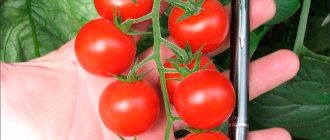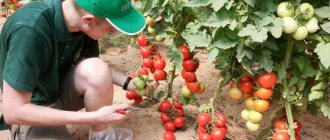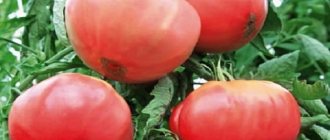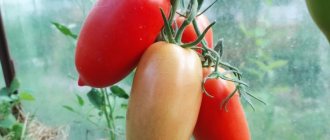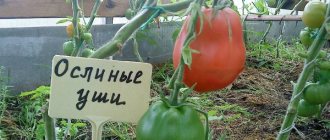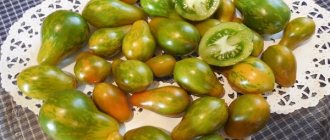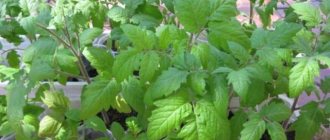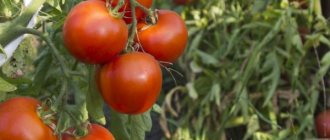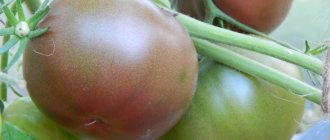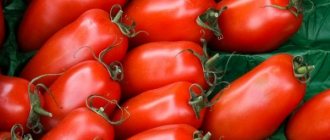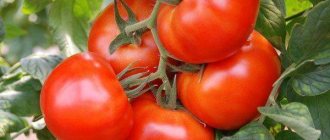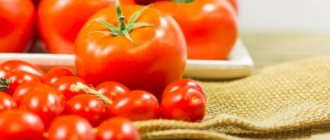Tomato Bolivar
photo author Olga Klyueva
Description and characteristics of tomato Bolivar F1, reviews, photos
Early maturing, determinate, productive tomato hybrid for open ground. Selection by Myazina L.A.
The bush is low-growing, with short internodes. Requires tying to the support and pinning. It is best to form a plant into 3-4 stems.
Basic qualities of fruits
The fruits are round, dense, red in color at maturity, weighing 150-200 grams, fleshy, good taste (for early ones). These tomatoes are suitable for salads and all types of processing.
The hybrid is resistant to major tomato diseases. Due to its early ripeness, it “escapes” late blight.
Features of cultivation, planting and care
We recommend sowing the seeds of this tomato for seedlings 50-55 days before the intended planting in the ground. Seedlings dive at the stage of two or three true leaves. When planting seedlings in a permanent place per 1 sq. It is recommended to place up to 5 plants per meter of plot.
Further care for tomatoes consists of timely watering, fertilizing with complex mineral fertilizer, pinching and preventive measures to protect against diseases and pests.
It is recommended to plant tomatoes in open ground when the threat of return spring frosts has passed. If low temperatures are still expected after transplantation, place arcs over the plantings and cover the plants with agrofibre or film.
If you grew Bolivar f1 tomatoes, please write whether you liked them or not. What was the yield and taste of the fruit? How tall were your tomatoes? Briefly describe the advantages and disadvantages of this tomato in your opinion. If possible, attach a photo of your harvest to the comment. Thank you!
Your feedback on the Bolivar tomato and additions to the description will help many gardeners evaluate this hybrid more objectively and decide whether it is worth growing or not.
Reviews
The first generation hybrid Bolivar F1 was bred not so long ago, but on the Internet it is easy to find reviews of summer residents who grew it. Opinions vary, but mostly positive. Summer residents discuss more about bush formation schemes and the need for pinching. Opinions differ on these issues. Some believe that there is no need for stepsons, others prefer to form 3-4 stems and remove excess stepsons.
Plant new Bolivar F1 super tomatoes at your dacha, share your impressions of the quality and quantity of tomatoes grown.
Sources:
https://otzovik.com/review_8378624.html https://prosorta.ru/opisanie-tomata-bolivar-f1-i-agrotehnika-vyrashivaniia/ https://tomatland.ru/catalog/3502 https://dachamechty. ru/tomat/rassada/bolivar.html
Description of tomato Bolivar F1 and agricultural cultivation techniques
Tomato Bolivar F1, the description of which classifies the hybrid as a series of large-fruited tomatoes, was obtained in the classical way as a result of hand pollination. Positive reviews about the variety are associated with disease resistance, early ripening, high yield, and universal use.
Advantages of a hybrid
The Bolivar tomato variety belongs to the selection of Ural agrobiologists. The tomato belongs to the first generation hybrids intended for cultivation in open ground. Determinate bushes form short internodes.
Description of the tomato variety Bolivar F1, its characteristics and yield
Tomato Bolivar from breeder L.A. Myazina is a hybrid obtained by the classical method of selection (hand pollination). Bolivar is part of the group of large-fruited tomatoes for open ground. During the work, certain goals were pursued:
- increasing resistance to diseases and bad weather conditions;
- improved taste;
- large fruits;
- early maturation;
- productivity.
The early ripening of the hybrid allows it to be grown in areas with short summers.
Description
The description of large-fruited tomatoes Bolivar F1 meets the wishes of most tomato lovers. The hybrid for open ground is characterized by high productivity - 4 kg of fruit per bush, which is 1.5 times higher than the productivity of older hybrids.
New generation tomatoes contain more useful elements than older varieties. Summer residents will appreciate the following valuable features:
- presentation of the fruit;
- transportability of tomatoes;
- excellent pickling qualities of tomatoes.
Bolivar F1 tomatoes are planted according to the 60*60 cm pattern. When placed on 1 sq. m. 2 bushes get maximum yield.
The fruits are large, red, tasty with fleshy pulp, and ripen 80 days after germination. The declared fruit weight is 200–250 g. Due to early ripening, the bushes do not suffer from late blight. The fruits of the Bolivar tomato are universal; their uses in cooking are varied.
Tips from Myazina
Lyubov Anatolyevna conducts seminars where she gives advice to amateur vegetable growers on how to properly grow tomatoes. Let's take a look at some of them. Perhaps they will help increase the productivity of our beds.
Sowing time
We calculate the sowing time as follows. The reference point is the approximate date of planting in the ground; from it you need to subtract the sum of days:
- the age of seedlings ready for transplanting is 45–55 days;
- 7 days for seed germination;
- 5 days to adapt after the pick.
In regions with short summers, there should be a bud on the second cluster before planting in the ground. In this case, all the fruits will ripen.
In order to get strong, healthy seedlings of early-ripening tomatoes by June 10, seeds for seedlings must be sown from April 1 to April 10. Having planted seedlings with buds during this time, the first tomatoes are harvested in open ground in mid-July.
About sowing seeds
Treat the seeds before sowing. First, place them in a weak solution of potassium permanganate for 20 minutes. To prepare it, 1 g of manganese crystals is dissolved in a partial glass of water. The next stage of processing is soaking the tomato seeds in any hormonal preparation:
Growth stimulants help accelerate seed germination, increase their immunity and stress resistance of tomatoes. Sow the seeds in the ground the next day, without waiting for them to hatch.
Sow the seeds to a depth of 2 cm. Compact the soil, then the sprout, breaking through the dense layer of soil, will throw off the flaps from the seed. To ensure friendly seedlings, always cover the box with seeds tightly with film.
Tomato seedlings absorb nutrients from the soil well at night temperatures of 14 °C and daytime temperatures of 16 °C. Under optimal conditions, tomato seedlings form good roots and produce more flowers.
Higher temperatures provoke excessive growth of stems in seedlings, weakening of roots and fewer flowers.
The effect of irrigation on the taste of tomatoes and the quality of seedlings
You cannot place boxes with seedlings on cold window sills, so that the soil does not overcool, you need to put any insulating material under them. Do not moisten the soil too much; the seeds will not have enough oxygen. For watering, use only warm water.
The agronomist believes that the quality of irrigation affects the taste of ripe tomatoes. In temperate climates, watering and loosening tomatoes in open ground should be completed when the fruits on the bushes begin to ripen. After harvesting ripened fruits, watering can be resumed.
Reviews
The first generation hybrid Bolivar F1 was bred not so long ago, but on the Internet it is easy to find reviews of summer residents who grew it. Opinions vary, but mostly positive. Summer residents discuss more about bush formation schemes and the need for pinching. Opinions differ on these issues. Some believe that there is no need for stepsons, others prefer to form 3-4 stems and remove excess stepsons.
Plant new Bolivar F1 super tomatoes at your dacha, share your impressions of the quality and quantity of tomatoes grown.
In the garden
Our article on growing tomatoes in open ground is based on the experience of growing the Bolivar tomato variety, a tall tomato intended for greenhouses, film tunnels and open ground.
Let's look at the results for this tomato variety in comparison with the Santa Cruz variety. When growing tomato seedlings and caring for the plants, no special conditions were created; our tomato bush grew in the same bed with its rivals Santa Cruz and De Barao.
The region where we conducted this experiment in growing tomatoes is the Voronezh region.
We planted Bolivar, Santa Cruz and De Barao tomatoes on May 10, the plants developed normally, all three varieties gained strength equally. When the ovary began to appear, the heat began, the thermometer in the sun went off scale at 45 degrees and above.
All hope was for watering. The “law of meanness” immediately comes into play: the water tower turned out to be unable to provide our experimental garden with sufficient water - enough for living, but not enough for watering. Two little rains helped. We survived.
Initially, we considered Bolivar tomatoes to be the same ordinary variety as other tall varieties of tomatoes. When saving the plants from the heat, they noticed that Bolivar needed more water than the others.
Accordingly, the grooves around the bushes were deepened and the tomatoes were watered abundantly.
We fed it twice with chicken droppings, tied it up as the bush grew, and by mid-July it became clear that there was a truly “royal” tomato in the beds. Why?
First of all, the indescribable beauty of the tomato bush itself: height up to 2-2.5 m, with numerous stepsons, additional stems and dense green foliage. At a height of 1.5-2 meters hang brushes, on which almost every tomato weighs up to 300 grams.
The annotation for the Bolivar variety says that the weight of each fruit is 120 grams. This is on average, and in our case individual specimens on the lower hands weighed 250-300 g.
And such kilogram brushes “hover” above the ground at a decent height - a miracle, right? I didn’t want to tear them off quickly, but rather admire and admire them longer...
The control Bolivar tomato bush was grown in open ground without pinching, the growing point on it was not pinched, the lower leaves were not torn off, but it was securely tied up.
So, this bush yielded a harvest of 22 kilograms of tomatoes, which would still grow and grow, but on September 29 the frost hit minus three... We have no doubt that if our tomatoes were grown not in open ground, but in a greenhouse, the fruits would grow would ripen until January.
Which varieties should it be classified according to ripening time? To be fair - none. It is “long-lasting”: it begins to ripen with early varieties and continues indefinitely until frost strikes.
Usually, by late autumn, after long-term storage, the taste of tomatoes changes; they become lethargic, dried out, or, conversely, softened. The same cannot be said about Bolivar tomatoes: they are perfectly preserved, do not rot, and do not turn black.
Once picked, tomatoes of this variety react in a special way to temperature conditions. They lie at a temperature of 10-15 degrees for almost two months and remain as if they had just been brought from the garden. And then they ripen “according to requests”: once you put them in a warm place, the tomatoes will ripen within a day.
When other tomatoes have to wait a week or two until they turn red in the warmth, Bolivar “obediently” turns red almost as soon as it is required of him.
Ripening in beds from the beginning of July until frost, Bolivar ripens in boxes from early autumn to infinity, incredibly surprising with this regime. In terms of ripening and keeping quality, it has no equal.
Resistance to late blight. The summer was dry, so late blight should not have occurred. But on August 6, a strong cold fog descended, and the next morning - “Hello, I am your late blight!” True, she turned out to be not evil, she did not touch the fruits, and the leaves dried out on all varieties except Bolivar and Santa Cruz. The bushes were green, which means that Bolivar is resistant to late blight.
Growing tomatoes
1. Bush without pinching with obligatory garter (the results have already been mentioned). 2. When forming a bush with 1-4 stems with pinching the growing point, removing the lower leaves, and rigid tying, the yield was: on a single-stem bush - 3.4 kg, on a two-stem bush - 5.1 kg, on a three-stem bush - 7.2 kg, on a four-stem bush - 8.0 kg of tomatoes.
After removing the shoots and extra stems, the plants looked depressed and lifeless. Burns appeared on the bare bushes, especially on the upper brushes. By mid-August, life in them had come to a standstill.
3. Bush without pinching and without garter (in a lying position). Productivity 10.6 kg.
The fruits ripened longer, there were fewer burns; With the beginning of the rains, slugs appeared on the fruits, and some tomatoes turned black.
If a “standing” bush without pinching brings joy and satisfaction to the gardener, then a “lying” one causes “moral damage.” You look at him and think: “Why did they offend you, poor thing?”
Bolivar made me understand that pinching depresses the plant, leads to loss of yield and a reduction in the vital activity of the bush.
Therefore, I will tell the stepson “stop” - there is no need to injure the plant, disturb it, or make it feel bad.
Bolivar tomatoes
Based on the results of growing our tomatoes, we will draw some conclusions about this tomato variety.
1. Cold-resistant, does not require shelter when planted in the ground.2. Drought resistant.3. The optimal growing option is a bush without pinching with obligatory garter.4. High resistance against late blight.5.
Suitable for pickling and canning. During heat treatment, the fruits do not spread,6. They are stored until late autumn without losing good taste.
7. Unique in terms of the length of the fruiting period.
And a few more words about the control tomato variety - Santa Cruz. This opponent of Bolivar is completely worthy of him. There is no big difference in yield between them, but Santa Cruz fruits are ideal for canning in small containers, and the more impressively sized Bolivar variety is ideal for pickling in large containers.
Reviews of Bolivar tomatoes
Bolivar sprouted perfectly, the plants were strong and grew quickly, ahead of other varieties. After only 10 days I picked them, and on May 3 I planted them in a greenhouse, and on the 15th - in open ground. I grew two bushes in the greenhouse - one stem with a garter and two. The plants bloomed at the end of May, with 4-5 tomatoes on one stalk.
The fruits are smooth, up to 200 grams, very tasty. I picked the first tomatoes on July 14, and in October I picked the last, green ones - 40 pieces from two bushes, they are still ripening (today is November 25). In open ground, the first tomatoes ripened only on August 10. I liked Bolivar better than Santa Cruz - I prefer large tomatoes. N.G.
BEDNENKO
Bolivar and Santa Cruz. In my opinion, they are incomparable, completely different. One has “cream” fruits, the other has round and large fruits. What they have in common: a huge number of tomatoes and their taste (both varieties are sweet). I sowed the seeds on March 18 (immediately after they were given to me).
This is a month later than I sow other tall tomatoes. I believe that this later affected the harvest. I planted tomatoes in the beds on May 29th. The first fruits were picked from my wards only on September 1st. It seems to me that for open ground the best way to grow is in two stems.
You may not get 18 kilograms, you will take nine, but the fruits are of high quality and beautiful. I grew two bushes without pinching. It was simply terrifying - huge, one and a half meters in diameter. All the stems were on the ground under the weight of the fruit.
We picked only a few tomatoes from these bushes; the rest were lost to late blight, mole crickets, snails and the Colorado potato beetle. I believe that they definitely need to be tied up and then we will always have a harvest.
L. V. LAGUTOCHKINA
I left one plant of the Bolivar variety in the nursery. It grew to one and a half meters (not very tall, I would say); The bush is spreading, so I tied it up. On the bush I counted 53 tomatoes weighing 100 grams or less. The fruits are round, red, very dense, tasty, sweet.
I didn’t plant bushes in the open ground, but tied them up. They grew up to a meter. There were few tomatoes, up to 30 on a bush. It was not possible to collect 16 kilograms from the bush (as they say in the annotation), but the variety is very good, the plants develop well and bear fruit in our conditions.
I collected the seeds and will grow them. 3. G. MARKOVA
Bolivar “didn’t seem like it” to me. The harvest was small, not all of the fruits ripened, but they turned out to be shelf-stable, beautiful, and tasty. But Santa Cruz is better. N. N. DONTSOVA
Santa Cruz and Bolivar tomatoes were grown in open ground with and without a garter - the yield was high in both cases. The most prolific bush turned out to be without a garter and without formation (pinching): clusters with fruits were like grapes. Good varieties, can be grown in any variety. N. I. OVSYANNIKOVA
Bolivar bushes have grown up to a meter 20 centimeters high. I tied it to stakes. Productivity is 6-8 pieces per bush, the fruits are large, dense, red, and taste sweet and sour. They sang later than the others, and after the rains none of them cracked. When it got cold, I picked green tomatoes (seven buckets) and brought them into the house. Today is November 27th, and we still have half a bucket of fresh tomatoes. N. N. BEZUGLAYA
Bolivar tomatoes are very productive, the fruits are red, round, fleshy, dense. The plants were mostly tied up and pinched. The stems of several untied bushes lay on the ground; these bushes gave almost no harvest: touching the ground, the branches took root and grew endlessly, but there were no tomatoes. T.F. KALININA
I missed your recommendation on the planting pattern, and Santa Cruz and Bolivar grew in closer proximity.
What happened was this: Bolivar had 30 large fruits on a bush with one stem, and 45 on bushes with two stems, not counting the small ones; on the unformed bushes there were from 30 to 40 large fruits and a lot of small fruits, which were killed by frost in the fall. Santa Cruz was better able to resist disease. N. V. EVTEEVA
The Bolivar variety was tested only in open ground. When forming a bush of 1-2 stems, the garter provided for by the test conditions was not required, since the bushes were up to a meter high with two or three fruits. When forming a bush of 3-4 stems, there were more tomatoes.
Growing without pinching and without garter gave a significantly better result, since the fruits were set on the stalks after harvesting from the main stems. I collected my last tomatoes on September 24, and throughout October they gradually ripen in boxes. I have been growing Santa Cruz for several years now.
In my opinion, Bolivar is inferior to it in terms of yield and keeping quality. N. K. GULEVSKAYA
Bolivar and Santa Cruz are tall, powerful, productive plants of late ripening. In open ground, Santa Cruz showed its best side - both in terms of yield and duration of fruiting.
All bushes were grown on supports with a garter, and only two (one of each variety) grew without a garter and lay on the ground. I consider this method unacceptable for tall tomatoes. In the greenhouse, both Bolivar and Santa Cruz were at their best. It's difficult to compare them.
Bolivar is a salad variety, Santa Cruz is good for canning. Still, it seems to me that Santa Cruz is more productive. V. I. OSMAKOVA
Growing tomatoes in open ground - Growing MORE INTERESTING ARTICLES: ☝Varieties of potatoes and tomatoes
With this article we begin a small series of materials in which we will introduce you to a description of the varieties of various vegetables and their characteristics.
In... ☝Protecting your garden from pests
If you planted blackcurrants, do not forget to plant tomato bushes next to them. This will protect your plants from very dangerous...
☝Varieties of carrots and cucumbers
We continue the series of articles about different varieties of vegetables and their properties and characteristics. In this article we will provide information about some...
☝Growing cauliflower
In terms of distribution among various types of cabbage, cauliflower ranks second after white cabbage. In our country, in the open...
Source: https://vsaduiogorode.ru/ogorod/233
Bolivar is a variety of tomato plant.
Variety characteristics:
Properties of the Bolivar variety:
Recommended region on the map:
Information on the admission of Tomato Bolivar from the Register of the State Variety Commission of the Russian Federation
Application for admission No. 62610, registered 2013-11-22. The Tomato variety Bolivar was included in the register of those approved in 2015. Approved for use in regions: All regions.
The originator of the Tomato Bolivar variety is:
- MYAZINA LYUBOV ANATOLYEVNA
Other varieties of tomato plant
Search for variety by name
Variety selection
Question to the portal experts
If you haven't found the answer to a question, don't hesitate to ask an expert.
Register or Login so you don't have to enter your Name and Email every time
Thanks for the comment! It will be published after checking by a moderator!
No comments yet, be the first!
A portal for those who love their dacha
Your question has been sent for moderation. Don't worry, we quickly check your questions and your question will be answered within 1 day.
We have noticed that you are already registered on our website. We recommend that you log in to view the question you created. If you don't remember your password, you can recover it.
You were not registered until today, so we have registered you. Your password has been sent to your specified mailbox.
Help our site develop!
Please read this message, it will not take up much of your time!
We so need your comments and questions to understand in which direction we should develop.
Don't forget to leave a comment if you found what you were looking for. And if you haven’t found it, use the “Ask an Expert” form in the site header. We will answer this question, and other visitors will be able to find the information that you could not find.
Sincerely, team of the portal Dacha-Dacha.ru
Your question has been sent for moderation. Don't worry, we quickly check your questions and your question will be answered within 1 day.
We have noticed that you are already registered on our website. We recommend that you log in to view the question you created. If you don't remember your password, you can recover it.
You were not registered until today, so we have registered you. Your password has been sent to your specified mailbox.
Description of the tomato variety Bolivar F1, its characteristics and yield
Tomato Bolivar from breeder L.A. Myazina is a hybrid obtained by the classical method of selection (hand pollination). Bolivar is part of the group of large-fruited tomatoes for open ground. During the work, certain goals were pursued:
- increasing resistance to diseases and bad weather conditions;
- improved taste;
- large fruits;
- early maturation;
- productivity.
The early ripening of the hybrid allows it to be grown in areas with short summers.
Description
The description of large-fruited tomatoes Bolivar F1 meets the wishes of most tomato lovers. The hybrid for open ground is characterized by high productivity - 4 kg of fruit per bush, which is 1.5 times higher than the productivity of older hybrids.
New generation tomatoes contain more useful elements than older varieties. Summer residents will appreciate the following valuable features:
- presentation of the fruit;
- transportability of tomatoes;
- excellent pickling qualities of tomatoes.
Bolivar F1 tomatoes are planted according to the 60*60 cm pattern. When placed on 1 sq. m. 2 bushes get maximum yield.
The fruits are large, red, tasty with fleshy pulp, and ripen 80 days after germination. The declared fruit weight is 200–250 g. Due to early ripening, the bushes do not suffer from late blight. The fruits of the Bolivar tomato are universal; their uses in cooking are varied.
Tips from Myazina
Lyubov Anatolyevna conducts seminars where she gives advice to amateur vegetable growers on how to properly grow tomatoes. Let's take a look at some of them. Perhaps they will help increase the productivity of our beds.
Sowing time
We calculate the sowing time as follows. The reference point is the approximate date of planting in the ground; from it you need to subtract the sum of days:
- the age of seedlings ready for transplanting is 45–55 days;
- 7 days for seed germination;
- 5 days to adapt after the pick.
In regions with short summers, there should be a bud on the second cluster before planting in the ground. In this case, all the fruits will ripen.
In order to get strong, healthy seedlings of early-ripening tomatoes by June 10, seeds for seedlings must be sown from April 1 to April 10. Having planted seedlings with buds during this time, the first tomatoes are harvested in open ground in mid-July.
About sowing seeds
Treat the seeds before sowing. First, place them in a weak solution of potassium permanganate for 20 minutes. To prepare it, 1 g of manganese crystals is dissolved in a partial glass of water. The next stage of processing is soaking the tomato seeds in any hormonal preparation:
Growth stimulants help accelerate seed germination, increase their immunity and stress resistance of tomatoes. Sow the seeds in the ground the next day, without waiting for them to hatch.
Sow the seeds to a depth of 2 cm. Compact the soil, then the sprout, breaking through the dense layer of soil, will throw off the flaps from the seed. To ensure friendly seedlings, always cover the box with seeds tightly with film.
Tomato seedlings absorb nutrients from the soil well at night temperatures of 14 °C and daytime temperatures of 16 °C. Under optimal conditions, tomato seedlings form good roots and produce more flowers.
Higher temperatures provoke excessive growth of stems in seedlings, weakening of roots and fewer flowers.
The effect of irrigation on the taste of tomatoes and the quality of seedlings
You cannot place boxes with seedlings on cold window sills, so that the soil does not overcool, you need to put any insulating material under them. Do not moisten the soil too much; the seeds will not have enough oxygen. For watering, use only warm water.
The agronomist believes that the quality of irrigation affects the taste of ripe tomatoes. In temperate climates, watering and loosening tomatoes in open ground should be completed when the fruits on the bushes begin to ripen. After harvesting ripened fruits, watering can be resumed.
Reviews
The first generation hybrid Bolivar F1 was bred not so long ago, but on the Internet it is easy to find reviews of summer residents who grew it. Opinions vary, but mostly positive. Summer residents discuss more about bush formation schemes and the need for pinching. Opinions differ on these issues. Some believe that there is no need for stepsons, others prefer to form 3-4 stems and remove excess stepsons.
Plant new Bolivar F1 super tomatoes at your dacha, share your impressions of the quality and quantity of tomatoes grown.
The effect of irrigation on the taste of tomatoes and the quality of seedlings
You cannot place boxes with seedlings on cold window sills, so that the soil does not overcool, you need to put any insulating material under them. Do not moisten the soil too much; the seeds will not have enough oxygen. For watering, use only warm water.
The agronomist believes that the quality of irrigation affects the taste of ripe tomatoes. In temperate climates, watering and loosening tomatoes in open ground should be completed when the fruits on the bushes begin to ripen. After harvesting ripened fruits, watering can be resumed.
We harvest a delicious harvest before anyone else - Bolivar F1 tomato: description and characteristics of the variety
Bolivar f1 is a giant tomato from the Myazina breeding group. The hybrid was obtained in the classical way through hand pollination. Recommended for climate zones with short summers.
| Height | Landing location | Ripening time | Fruit color | Fruit size | Origin | Fruit shape |
| Tall | Open ground | Early ripening | Reds | Large | Hybrid | Flat-round |
Description and characteristics of the variety
Bolivar is intended for growing in open beds. It is cold-resistant and does not need shelter. It is a determinate hybrid with early ripening - tomatoes turn red after 80-95 days from germination. It grows up to 2 m in height and is classified as tall.
The fruits are deep red in color, fleshy, sugary, juicy at the break. The average weight is in the range of 210-250 g. The tomatoes ripen together with a beautiful, neat brush. There are 7-8 fruiting bunches in total, with 5-6 tomatoes on each.
Advantages and disadvantages
- early ripeness;
- large fruit;
- productivity;
- simplicity of agricultural technology;
- transportability;
- disease resistance;
- endurance to temperature changes.
Minuses:
- impossibility of whole-fruit canning.
Productivity
4-4.5 kg are harvested from 1 plant, 12-14 kg from 1 m2. The largest tomatoes weigh 350 g. One-kilogram clusters hover above the ground. The fruits are used for pickling, canning, and salads.
Features of cultivation and storage
Seeds are sown in March - first, second decade. Use light fertile soil with the addition of compost and peat. To speed up the emergence of seedlings, place them in Epin-Extra or Agat-25 for 30 minutes.
Sowing and caring for seedlings:
- Seeds are planted to a depth of 2 cm.
- The containers are kept warm until germination and covered with glass.
- Irrigate through a spray bottle.
- They dive when there are 2 true leaves.
